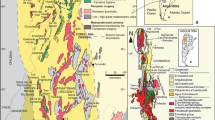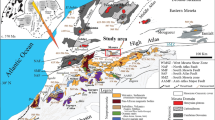Abstract
The Tiscapa maar in the center of Managua city formed by a phreatomagmatic eruption <3 ka ago. The eruption excavated a crater deep into the basement exposing a coherent Pleistocene to Holocene volcaniclastic succession that we have divided into four formations. The lowermost, >60 ka old basaltic–andesitic formation F1 comprises mafic ignimbrites and phreatomagmatic tephras derived from the Las Sierras volcanic complex south of Managua. Formation F2 contains the ~60 ka basaltic–andesitic Fontana tephra erupted from the Las Nubes Caldera of the Las Sierras complex 15 km to the S, the 25 ka Upper Apoyo tephra from the Apoyo Caldera 35 km to the SE, and the Lower (~17 ka) and Upper (12.4 ka) Apoyeque tephras from the Chiltepe volcanic complex 15 km to the NW. These tephras are separated by weathering horizons and paleosols indicating dry climatic conditions. Fluvial deposits of a SSW-NNE running paleo-river system build formation F3. The fluvial sediments contain, from bottom to top, scoriae from the ~6 ka basaltic San Antonio tephra, pumice lapilli from the Apoyo and Apoyeque tephras and the 6.1 ka Xiloà tephra, and scoriae derived from the Fontana tephra. The fluvial sediment succession thus reflects progressively deeper carving erosion in the southern highlands (where a large-amplitude regional erosional unconformity exists at the appropriate stratigraphic level) that began after ~6 ka. This suggests that the mid-Holocene tropical high-precipitation climatic phase affected western Nicaragua about a thousand years later than other circum-Caribbean regions. The end of the wet climate phase ~3 ka ago is recorded by a deep weathering zone and paleosol atop formation F3 prior to the Tiscapa eruption. Formation F4 is the Tiscapa tuffring composed of pyroclastic surge and fallout deposits that cover a minimum area of 1.2 km2. The 4 × 109 kg of erupted basaltic magma is compositionally and genetically related to the low-Ti basalts of the N–S striking Nejapa-Miraflores volcanic–tectonic alignment 5 km to the West of Tiscapa. Ascent and eruption mode of the Tiscapa magma were controlled by the Tiscapa fault that has a very active seismic history as it achieved 12 m displacement in about 3000 years. Managua city is thus exposed to continued seismic and volcanic risks.















Similar content being viewed by others
References
Bice DC (1985) Quaternary volcanic stratigraphy of Managua, Nicaragua: correlation and source assignment for multiple overlapping plinian deposits. Geol Soc Am Bull 96:553–566
Brown RD, Ward PL, Plafker G (1973) Geologic and seismologic aspects of the Managua, Nicaragua, earthquakes of December 23, 1972. U.S. Geological Survey Prof. Paper 838, 34 pp
Carr MJ (1984) Symmetrical and segmented variation of physical and geochemical characteristics of the Central American Volcanic Front. J Volcanol Geotherm Res 20:231–252
Carr MJ, Rose WI Jr, Stoiber RE (1982) Central America. In: Thorpe RS (ed) Orogenic andesites and related rocks. Wiley, New York, pp 149–166
Clarke H, Troll VR, Carracedo JC (2009) Phreatomagmatic to strombolian eruptive activity of basaltic cinder cones: Montaña Los Erales, Tenerife, Canary Islands. J Volcanol Geotherm Res 180:225–245
Cowan H, Prentice C, Pantosti D, de Martini P, Strauch W, Workshop participants (2002) Late Holocene earthquakes on the Aeropuerto Fault, Managua, Nicaragua. Bull Seism Soc Am 92:1694–1707
Cronin SJ, Lecointre JA, Palmer AS, Neall VE (2000) Transformation, internal stratification, and deposition of a channelised, multi-peaked lahar flow. NZ J Geol Geophys 43:117–128
Curtis JH, Brenner M, Hodell DA, Balser RA, Islebe GA, Hooghiemstra H (1998) A multi-proxy study of Holocene environmental change in the Maya lowlands of Peten, Guatemala. J Paleolimnol 19:139–159
DeMets C (2001) A new estimate for present-day Cocos-Caribbean plate motion: implications for slip along the Central American volcanic arc. Geophys Res Lett 28:4043–4046
Fisher RV, Schmincke H-U (1984) Pyroclastic rocks. Springer Verlag, Berlin, Heidelberg, New York, Tokyo, 472 pp
Freundt A, Schmincke HU (1986) Emplacement of small-volume pyroclastic flows at Laacher See (East-Eifel, Germany). Bull Volcanol 48:39–59
Freundt A, Kutterolf S, Schmincke HU, Hansteen TH, Wehrmann H, Perez W, Strauch W, Navarro M (2006) Volcanic hazards in Nicaragua: past, present, and future. In: Rose WI, Bluth G, Carr MJ, Ewert J, Patino L, Vallance J (eds) Volcanic hazards in Central America. Geol Soc Am Spec Pap 412:141–165. doi: 10.1130/2006.2412(08)
Garbe-Schönberg D (1993) Simultaneous determination of 37 trace elements in 28 international rock standards by ICP-MS. Geostand Newslett 17:81–93
Gevrek AI, Kazanci N (2000) A Pleistocene, pyroclastic-poor maar from central Anatolia, Turkey: influence of a local fault on a phreatomagmatic eruption. J Volcanol Geotherm Res 95:309–317
Giordano G, De Rita D, Cas RAF, Rodani S (2002) Valley pond and ignimbrite veneer deposits in the small-volume phreatomagmatic ‘Peperino Albano’ basic ignimbrite, Lago Albano maar, Colli Albani volcano, Italy: influence of topography. J Volcanol Geotherm Res 118:131–144
Girard G, Van Wyk de Vries B (2005) The Managua Graben and Las Sierras-Masaya volcanic complex (Nicaragua); pull-apart localization by an intrusive complex: results from analogue modeling. J Volcanol Geotherm Res 144:37–57
Godchaux MM, Bonnichsen B, Jenks MD (1992) Types of phreatomagmatic volcanoes in the western Snake River Plain, Idaho, USA. J Volcanol Geotherm Res 52:1–25
Haug GH, Hughen KA, Sigman DM, Peterson LC, Röhl U (2001) Southward migration of the intertropical convergence zone through the Holocene. Science 293:1304–1308
Higuera-Gundy A, Brenner M, Hodell DA, Curtis JH, Leyden BW, Binford MW (1999) A 10, 300 14C yr record of climate and vegetation change from Haiti. Quat Res 52:159–170
Hodell DA, Curtis JH, Jones GA, Higuera-Gundy A, Brenner M, Binford MW, Dorsey KT (1991) Reconstruction of Caribbean climate change over the past 10, 500 years. Nature 352:790–793
Hodell DA, Brenner M, Curtis JH, Medina-Gonzáles R, Ildefonso-Chan Can E, Albornaz-Pat A, Guilderson TP (2005) Climate change on the Yukatan peninsula during the Little Ice Age. Quat Res 63:109–121
Kutterolf S, Freundt A, Pérez W, Wehrman H, Schmincke HU (2007) Late Pleistocene to Holocene temporal succession and magnitudes of highly-explosive volcanic eruptions in west-central Nicaragua. J Volcanol Geotherm Res 163:55–82
Kutterolf S, Freundt A, Peréz W, Mörz T, Schacht U, Wehrmann H, Schmincke H-U (2008) The Pacific offshore record of Plinian arc volcanism in Central America, part 1: along-arc correlations. Geochem Geophys Geosyst 9:Q02S01. doi:10.1029/2007GC001631
Lachniet MS, Asmerom Y, Burns SJ, Patterson WP, Polyak VJ, Seltzer GO (2004) Tropical response to the 8200 yr B.P. cold event? Speleothem isotopes indicate a weakened early Holocene monsoon in Costa Rica. Geology 32:957–960
Lara LE, Lavenu A, Cembrano J, Rodriguez C (2006) Structural controls of volcanism in transversal chains: resheared faults and neotectonics in the Cordón Caulle–Puyehue area (40.5°S), Southern Andes. J Volcanol Geotherm Res 158:70–86
Lorenz V (1974) Vesiculated tuffs and associated features. Sedimentology 21:273–292
Lorenz V (1986) On the growth of maars and diatremes and its relevance to the formation of tuff rings. Bull Volcanol 48:265–290
McBirney AR, Williams H (1965) Volcanic history of Nicaragua, vol 55. University of California, Berkeley, USA, p 63
McDonough WF, Sun SS (1995) The composition of the Earth. Chem Geol 120:223–253
Neff H, Pearsall DM, Jones JG, Arroyo de Pieters B, Freidel DE (2006) Climate change and population history in the Pacific lowlands of southern Mesoamerica. Quat Res 65:390–400
Pardo N, Avellan DR, Macias JL, Scolamacchia T, Rodriguez D (2008) The 1245 yr BP Asososca maar: new advances on recent volcanic stratigraphy of Managua (Nicaragua) and hazard implications. J Volcanol Geotherm Res 176:493–512. doi:10.1016/j.jvolgeores.2008.04.020
Pérez W, Freundt A (2006) The youngest highly explosive basaltic eruptions from Masaya Caldera (Nicaragua): stratigraphy and hazard assessment. In: Rose WI, Bluth G, Carr MJ, Ewert J, Patino L, Vallance J (eds) Volcanic hazards in Central America. Geol Soc Am Spec Pap 412:189–207. doi: 10.1130/2006.2412(10)
Perez W, Freundt A, Kutterolf S, Schmincke HU (2009) The Masaya Triple Layer: a 2100 year old basaltic multi-episodic Plinian eruption from the Masaya Caldera Complex (Nicaragua). J Volcanol Geotherm Res 179:191–205
Piperno DR, Jones JG (2003) Paleoecological and archaeological implications of a late Pleistocene/early Holocene record of vegetation and climate from the Pacific coastal plain of Panama. Quat Res 59:79–87
Putirka KD (2008) Thermometers and barometers for volcanic systems. In: Putirka KD, Tepley FJ III (eds) Minerals, inclusions and volcanic processes, Rev Miner Geochem 69:61–120
Rausch J, Schmincke HU (2009) Nejapa Tephra: the youngest (c. 1 ka BP) highly explosive hydroclastic basaltic eruption in western Managua (Nicaragua). Berichte aus der Geowissenschaft, Shaker Verlag, Aachen, Germany, 51 pp
Roche O, Van Wyk de Vries B, Druitt TH (2001) Sub-surface structures and collapse mechanisms of summit pit craters. J Volcanol Geotherm Res 105:1–18
Rymer H, Van Wyk de Vries B, Stix J, Williams-Jones G (1998) Pit crater structure and processes governing persistent activity at Masaya volcano, Nicaragua. Bull Volcanol 59:345–355
Sebesta J (1997) Dynamic development of the relief in the Managua area, Nicaragua. Acta Univ Carol Geogr 2:93–109
Stoiber RE, Carr MJ (1973) Quaternary volcanic and tectonic segmentation of Central America. Bull Volcanol 37:304–325
Sussman D (1985) Apoyo Caldera, Nicaragua: a major Quaternary silicic eruptive center. J Volcanol Geotherm Res 24:249–282
van Wyk de Vries B (1993) Tectonics and magma evolution of Nicaraguan volcanic systems. PhD thesis, unpublished, Open University, Milton Keynes, UK, 328 pp
Walker JA, Carr MJ, Feigenson MD, Kalamarides RI (1990) The petrogenetic significance of interstratified high- and low-Ti basalts in central Nicaragua. J Petrol 31:1141–1164
Walther CHE, Flueh ER, Ranero CR, von Huene R, Strauch W (2000) Crustal structure across the Pacific margin of Nicaragua: evidence for ophiolitic basement and a shallow mantle sliver. Geophys J Int 141:759–777
Ward PL, Gibbs J, Harlow D, Aburto-Q A (1974) Aftershocks of the Managua, Nicaragua, earthquake and the tectonic significance of the Tiscapa fault. Bull Seism Soc Am 64:1017–1029
Wehrmann H, Bonadonna C, Freundt A, Houghton BF, Kutterolf S (2006) Fontana Tephra: a basaltic plinian eruption in Nicaragua. In: Rose WI, Bluth G, Carr MJ, Ewert J, Patino L, Vallance J (eds) Volcanic hazards in Central America. Geol Soc Am Spec Paper 412:209–223
Weinberg RF (1992) Neotectonic development of western Nicaragua. Tectonics 11:1010–1017
Weyl R (1980) Geology of Central America. In: Bender F et al (eds) Beiträge zur regionalen Geologie der Erde, 2nd edn. vol 15, Gebr. Borntraeger, Berlin, Stuttgart, pp 371
White JDL, Schmincke H-U (1999) Phreatomagmatic eruptive and depositional processes during the 1949 eruption on La Palma (Canary Islands). J Volcanol Geotherm Res 94:283–304
Acknowledgments
We acknowledge the support by the Instituto Nicaragüense de Estudias Territoriales (INETER) in Managua during field work as well as the permission of the park service to work in the Parque Histórico Nacional Loma de Tiscapa. Field work was supported by a scholarship of the Deutscher Akademischer Austausch Dienst (DAAD) to AH. We thank K. Nemeth and J. Walker for helpful reviews of an earlier version of this paper. This publication is contribution no. 139 of the Sonderforschungsbereich 574 “Volatiles and Fluids in Subduction Zones” at Kiel University.
Author information
Authors and Affiliations
Corresponding author
Electronic supplementary material
Below is the link to the electronic supplementary material.
Rights and permissions
About this article
Cite this article
Freundt, A., Hartmann, A., Kutterolf, S. et al. Volcaniclastic stratigraphy of the Tiscapa maar crater walls (Managua, Nicaragua): implications for volcanic and seismic hazards and Holocene climate changes. Int J Earth Sci (Geol Rundsch) 99, 1453–1470 (2010). https://doi.org/10.1007/s00531-009-0469-6
Received:
Accepted:
Published:
Issue Date:
DOI: https://doi.org/10.1007/s00531-009-0469-6




